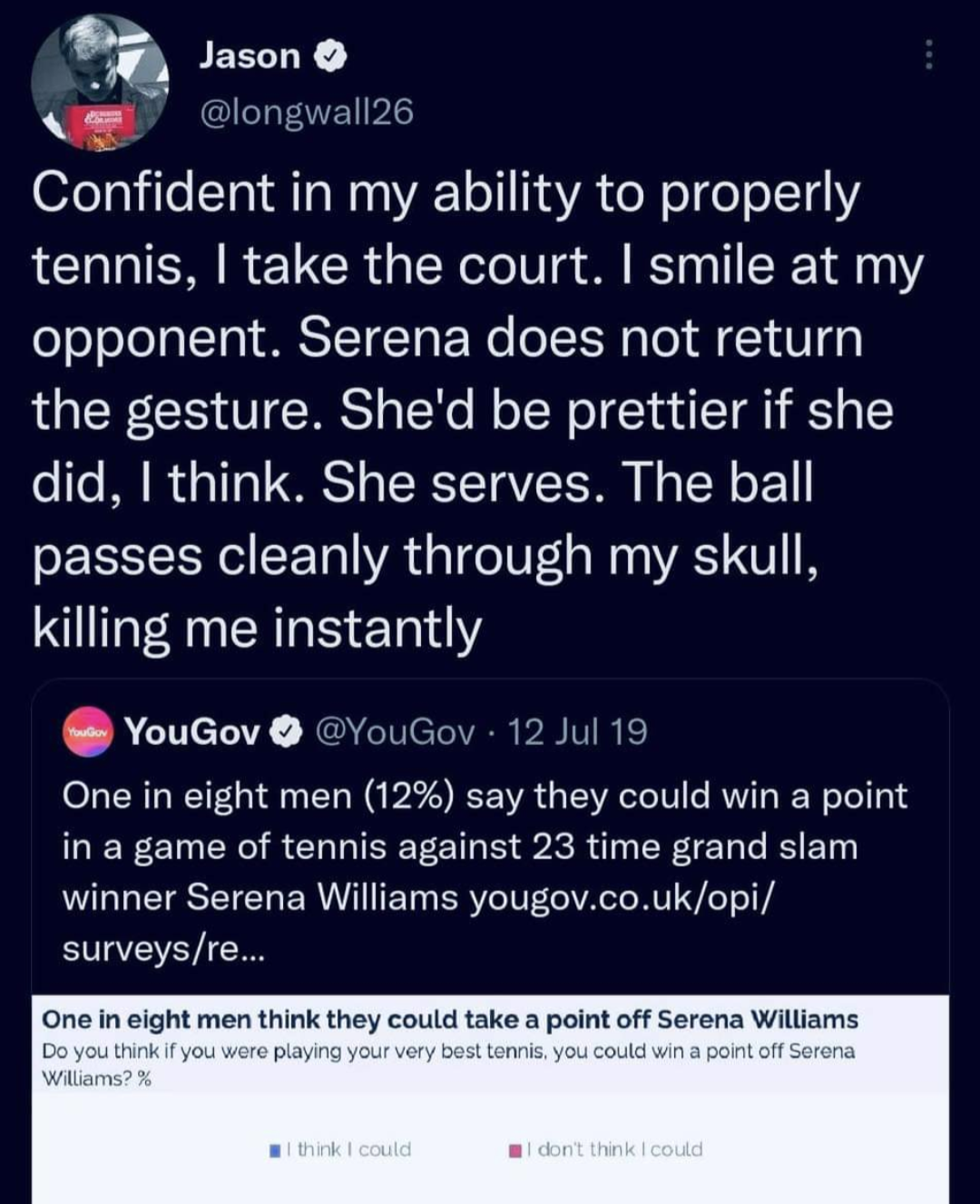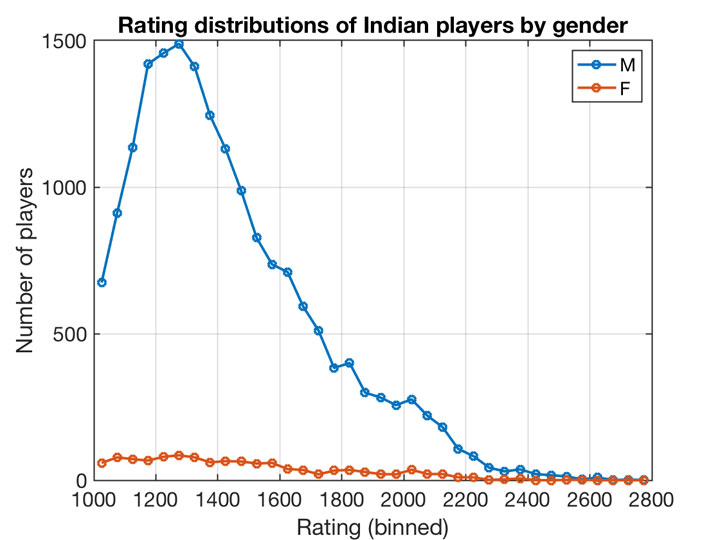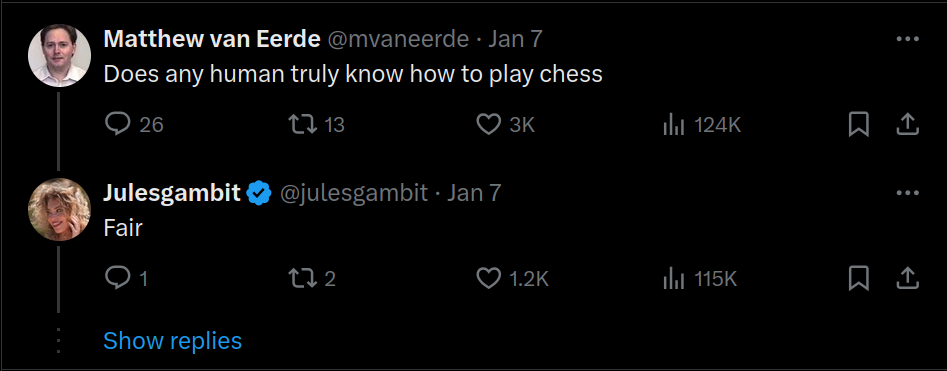you dislike the botez sisters for being women in your hobby
i dislike the botez sisters for defending slavery in the UAE
we are not the same
They’re also kkkanadian.
So many chess players salivate over the potential for gulf sportswashing money
Damn I should have known one of yinz would beat me to the punch…I love Hexbear.
i can fix alex botez
Imagine being mad that conventionally attractive women share the same hobby as you … Oh wait, this person is probably a tourist
Everyone knows the best chess players are either 10 year old boys or 65 year old men that look like Rasputin post homicide, everyone else is a liar
65 year old men that look like Rasputin post homicide,
I think you meant scarily skinny Indian men lol.
You’d have to be less than a tourist to make that comment. Even a cursory glance at Jules’ social media (threads, insta, twitter) would show you she’s a top 100 women’s chess player immediately. It’s also all she talks about. And if you wandered over to twitter you’d see Alex and Andrea’s accounts too. The only thing they have in common is her being a woman and him hating women.
In a just world rtm135 would be forced to play a shadow game in which he must beat every single one of these women at Chess or be banished to the Shadow Realm
same energy:

I think people in general don’t appreciate how fucking hard of a game tennis really is, along with the misogyny.
There’s no way in hell 12% of the respondents even play tennis with any regularity lmao
I think people just regularly overestimate their abilities in all sorts of things they’ve never or barley tried. They simply don’t know how hard it is since they haven’t. That plus sexism for this attitude
If I say I can beat her will I get the chance to play with a world class athlete? I’ve never played tennis.
Pfft, I could absolutely do that
Assuming she was 10 minutes late to the game and the umpire let me start without her
When I first came upon this question years ago, I was like “A game of tennis goes for like 3 hours, surely I could get a singular point in that time, if she faults”
Then I was informed “winning a point” means winning a set, so I revised my answer to “Yeah absolutely not”.
Maybe some of that 12% had the same thought process I did, but even then that’s a ridiculously high number
Winning a point does just mean a single service, and it’s still true. Tennis pros only fault because they’re playing on the bleeding edge of their game to beat their peers. Serena Williams can play at 50% of her capability against you, never come close to a fault, and wrap up the match in 30 mins.
Horrible taste in men though.
I guess relying on your opponent to fuck up isn’t a reliable strategy unless your opponent is the US government.
nah, he will get one attempt per month in the gulag.
Sexy lady no use brain, only man use brain, me man me smart.
at least one is a women’s chess master
Waaaait wait wait wait, Chess titles are STILL SEX SEGREGATED?! I THOUGHT THAT WAS A THING FROM LIKE THE 60’s! THE FUCK
It’s not that they’re strictly segregated. There are no tournaments women cannot play in or titles women cannot earn. But there are tournaments only women can play in and only women can earn.
So a woman can be a grandmaster and a woman’s grandmaster, but a man can only be a grandmaster. It’s meant as a way of addressing the gender imbalance in chess. It’s a system that has allowed a lot of women who would not otherwise be able to to hold titles, win prize money and make a career out of competitive chess but some women, especially the really strong ones who are able to compete at the highest level and hold the general titles do feel they’re condescending, the requirements are lower so a woman’s master title is less prestigious than a plain master title, and that they reinforce structural sexism and encourage young woman prodigies and the people training and supporting them to aim lower and limit their ambitions. Judith Polgar, possibly the strongest woman ever to play the game, thinks they should be abolished. But obviously a lot of women players who are making a living and take pride in playing almost exclusively women’s tournaments disagree. It’s a hotly debated topic.
Also worth noting that trans women are also barred from women’s-only tournaments, because international chess is governed by reprehensible people.
“you see, if you go through testosterone puberty you will get a certain bone density that gives you an unfair advantage in remembering how the little horses and castles move”

It’s true, all of my mental prowess comes from the boners in my brain bones
Yeah that’s vile.
FIDE is a reactionary institution.
Some federations are better. The USCF has made an attempt not to be transphobic. Players registered with them can submit and change their own gender identification. The Norwegian Chess federation is also cool and has been lobbying lobbying FIDE to stop being shitlords. Federations also have their own title systems and some have women’s titles.
Oh sick actually
It’s a TERF institution in the year of our lord 2025
oh decidedly not cool…
I’ll be honest I only read the first like two sentences of the response I replied to
It’s not entirely fendered, there’s women’s and mixed events and women’s and mixed titles. The women’s only events and titles were a tactic to encourage participation.
deleted by creator
What does this mean?
Chess gene is on Y chromosome
(Realistically, a lot of women would be harassed out of the scene before they get to grand master level)
Yeah, the part about harassment is the whole reason why there are women’s tournaments in the first place. Women chess players have requested these spaces remain a thing because surprise surprise, most chess players are misogynist and make it hell for women participating in tournaments.
Are you on the wrong instance, or is this just a statistics joke because some men would win definitionally meaning fewer women
I think the joke is that women Grandmasters is a separate title to Grandmaster (who happens to be a woman) due to women having a women’s league as well as the mixed gender while men only have the mixed gender.
The only reason men dominate chess is that there are more male players. There’s no skill gap, just a participation gap, probably because of guys like that
https://en.chessbase.com/post/what-gender-gap-in-chess
long but worth a read—and there are figures and headings. TLDR, statistical analysis finds that sample size overwhelmingly explains male chess dominance
[…] to fairly compare an underrepresented to an overrepresented group, you should never use the top individuals. […]
A Thought Experiment
[…] It’s really quite simple. Let’s say I have two groups, A and B. Group A has 10 people, group B has 2. Each of the 12 people gets randomly assigned a number between 1 and 100 (with replacement). Then I use the highest number in Group A as the score for Group A and the highest number in Group B as the score for Group B. On average, Group A will score 91.4 and Group B 67.2. The only difference between Groups A and B is the number of people. The larger group has more shots at a high score, so will on average get a higher score. The fair way to compare these unequally sized groups is by comparing their means (averages), not their top values. Of course, in this example, that would be 50 for both groups – no difference!
Indian women play as well as men on average
At this point, you might think that this is just a theoretical argument – surely, when looking at chess ratings, it cannot be that simple? So let’s have a closer look at chess ratings. I downloaded the October 6, 2020 FIDE Standard rating list, selected all players of the Indian federation, and removed all junior players (born 2000 or later), since their ratings are often not reliable. I was left with 19,064 players, of whom 17,899 (93.9%) were male and 1,165 (6.1%) were female. The best male player was a certain Viswanathan Anand at 2753, and the best female player was Humpy Koneru at 2586 – a gap of 167 points. GM Koneru, ranked 15th among all Indian players, is the only female in the top 20. On the surface, these facts superficially seem to point to a gender gap in achievement.

The huge discrepancy between the blue and orange lines reflects the participation gap. To compare the distributions more easily, we change the vertical axis from number of players to proportion of players (within each gender):

The line for female players is more jagged because there are fewer of them, but other than that, these two distributions don’t look radically different from each other. Indeed, the average ratings of men (1434) and women (1466) are comparable. And averages are the fairer metric for comparing men and women.
Is 167 points an unexpectedly large gap [between the top male and top female Indian chess player]?
But this does not answer our questions. Is, for example, a gap of 167 points between the male and female top players unexpectedly large? To answer this question, we are now going to look at all ratings as a single pool, dropping the gender identifiers altogether. We then randomly draw 17,899 ratings from this pool. These form the “overrepresented” group, and the remaining 1,165 ratings form the “underrepresented” group. These numbers are exactly the numbers of male and female players in our data, but we have instead created completely arbitrary groups with these numbers of individuals. We record the top rating in both groups. We repeat this process 100,000 times. (For the aficionados: we are following the logic of permutation tests.)
Guess what? The difference between the top ratings in the Overrepresented and Underrepresented groups is a whopping 153 points on average (with a standard deviation of 93). Again, remember that these groups are completely identical to each other except in their number of individuals. The mere fact that the underrepresented group constitutes only 6.1% of the population causes a large difference in top ratings. In this light, the real gap of 167 points could easily be due to chance instead of due to a real difference between women and men, just like the gap in our thought experiment. It is that simple.
Other widely used metrics don’t show evidence for a gender gap either. For example, based on participation alone, one would expect only 1.2 female players in the top 20 overall. So Humpy Koneru being the only female in the Indian top 20 is completely in line with statistical expectations based on the participation gap.
Conclusion
We conclude that at least among non-junior FIDE-rated Indian players, there is no evidence that the “achievement gap” is anything but a participation gap. That is not to deny the first-person perspective of top female players, who might feel that they have reached a personal ceiling in their performance. But statistically, there is nothing to suggest that top female players are underperforming given the overall ratio of female to male players. In fact, taking into account the systemic injustices and biases that they had to overcome to get where they are, they are likely overperforming.
Take-aways:
-
If you want to compare chess achievements between men and women, given their vastly unequal numbers, it is a very bad idea to focus on the top male and female players.
-
If you insist to focus on the top players, you will have to account for the participation gap using an analysis similar to the one presented here. Just a casual remark won’t do it!
-
Even if, hypothetically, you were to find a gender difference based on average ratings (rather than top ratings), you cannot jump to the conclusion that that difference is due to innate or biological factors. The first place to look would be systemic disadvantages and stereotype threat experienced by female players.
The statistical arguments presented in this article are elementary enough for an introductory statistics class in university. In case you want to repeat the analysis for different countries, you can check my Matlab code for the details. If you prefer to read a published paper, look no further than this excellent paper by Merim Bilalić, Kieran Smallbone, Peter McLeod, and Fernand Gobet (2009). (The free PDF can be found through Google Scholar.) Its title is the first question everyone should be asking: Why are (the best) women so good at chess? And everyone’s second question should be: How can we reduce the insane participation gap?
-
The only non female character in chess is the King. All.othwr pieces are trans and become queens when they cross the board if they aren’t Afab pawns, building or horses. Sorry you can’t find that hot.
Why are women so damn pretty??!!

The only ChessPlayer™ I ever knew is a woman that was kinda evil back then
All 6 of them are chess streamers
There’s a joke in here if you thread the needle about how anybody under 2500 ELO doesn’t know chess. But, as has been discussed, it’d be 2500 FIDE and it’s a reactionary institution so it’s not really going to make it through the eye of the needle.
God fucking dammit I blundered so fucking hard ??

My beef is more like can you only win at one thing please
Chess is an ugly man’s game obviously.
Damn i did not know there were so many people on hexbear that paid attention to chess.
If anyone wants a friendly EZ game sometime, holler at me!
I say EZ cause I ain’t great, just know the rules and play once every few years
me moving the knight and making clippity cloppy sounds wee
When I move the bishop I always make a fiuuup sound tho I should be making nonce sounds I guess
when i move the rook i make the exact impression of a rock being split in half
why do you call it “rook”, it’s a tower
I’m about to head to bed, but I play casually too and would love to play a friendly game some time.
Hmu on lichess.org!
Username RustyArizona
The only chess tactic I can reliably pull off is the Botez Gambit
Left to right, I recognize Anna Cramling (WFM), Nemo Zhou (FM/WGM), don’t know, possibly Andrea Botez?, don’t know, Alexandra Botez (WFM).
don’t know is, I believe, 22 year old Jennifer Yu, FIDE master, woman grandmaster, and 2 time US women’s champion with a current classical rating of 2283. She is the highest rated of all of them edging out even Dina Belenkaya by a couple dozen rating.


























